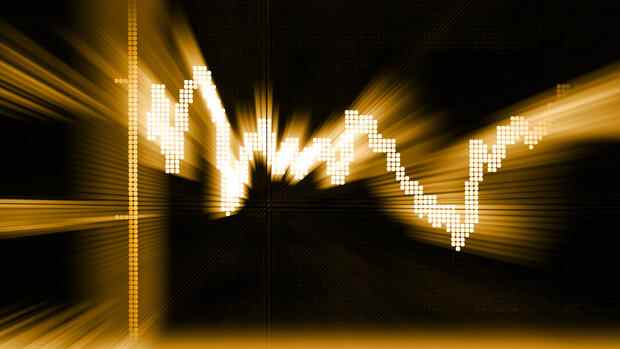Dusseldorf Groundbreaking trading days are imminent on the German stock market. The question at stake is whether the stock market year 2022 will be miserable or at least reasonably decent.
In concrete terms, this means that if the Dax falls below the 13,500 point mark for a long time, there is a risk of a longer consolidation phase from a technical point of view, from which the German stock market is unlikely to recover so easily.
There was already a first sign of a slide towards 13,500 points on today’s trading day. The Dax lost almost 200 points to 13,707 points in the first few minutes of trading. The leading index has thus reached a new “war low” and at the same time a new low for the year.
But at the level of 13,700 points, there is obviously high demand. This caused a recovery that caused the leading index to turn positive again. At the close of trading, the Dax reached the 14,000 point mark and was up 0.7 percent.
The low for the year so far of 13,807 points had a special character. When the low was reached, there was a panic sell-off, a fall with parallel high trading volume, which could be interpreted as a sign of a bottoming according to sentiment analysis. But that’s history.
The mood had already deteriorated significantly on Tuesday. Within the last two hours of trading, the stock exchange barometer slipped 300 points and closed with a minus of 3.9 percent at 13,904 points below the psychologically important mark of 14,000 points.
A look at the long-term chart shows why the mark of 13,500 points is so relevant. From 2017 to 2020, the annual high was always in this area. Technical analysts are calling this a key resistance. And when the Dax was able to sustainably overcome this mark, a textbook rise to over 16,000 points followed. For the technical analysts of HSBC Germany “it is absolutely necessary to defend this brand”.
On the other hand, it can also be stated that: The search for the so-called “safe havens” subsided after the recent significant price movements on Wednesday. Gold prices fell 1.1 percent to $1,923. The same applies to the Silver price, which even lost 1.5 percent at $ 25.02.
The yield on ten-year Bunds, which slipped back into the red on Tuesday, did not fall any further and was listed at minus 0.007 percent. Thomas Altmann from the investment house QC Partners is certain: “The safe havens are stabilizing at high levels.”
Oil prices climb to new multi-year highs
Oil prices continued to rise significantly in light of the war in Ukraine. On Wednesday, the two most important types of oil, Brent and West Texas Intermediate (WTI), again marked multi-year highs.
A barrel (159 liters) of the North Sea Brent cost up to $112.15, which is the last time it was in 2014. A barrel of the US brand WTI was traded at up to $110.59. This is the highest level since 2013. Most recently, the price for WTI oil was $106.86, Brent at $109.22.
Stock exchange in Moscow remains closed
However, there was no trading on the Moscow Stock Exchange on Wednesday either. The central bank reports this. However, some selected transactions at the trading venue should be possible for the first time this week.
The dollar traded tight against the Russian currency above the mark of 100 rubles. On Tuesday, the greenback hit a new record high of 117 rubles.
According to foreign exchange expert Ulrich Leuchtmann, there is a risk that the ruble will be banned from the global foreign exchange market in the long term. With every passing day of horror reports from Ukraine, it is becoming less likely that Russia’s economic relations with the rest of the world will return to normal in the medium term. “This is the economic price that Russia’s military and political leadership has to pay for continuing military operations even after the original attack plans have failed.”
Stocks of commodity producers and traders were among the winners amid sharply rising commodity prices. The price gains of Aurubis, Salzgitter, Thyssen-Krupp and Klöckner & Co ranged from almost two to more than six percent. Last but not least, a failure of Ukraine as a steel exporter could result in a shortage of supply on the European markets, wrote Jefferies analyst Alan Spence.
Look at the individual values
Shop pharmacy: Increased depreciation caused the online pharmacy to make a higher loss in 2021. The Executive Board justified the depreciation of 27 million euros with the commissioning of the new logistics center, company acquisitions and increased IT investments. The share, which has already lost around a third of its value since the beginning of the year, was up around one percent at the end of trading on Wednesday.
With the last year’s low of EUR 75.50, the paper is only just above the high from 2017 of over EUR 64. An interesting comparison of how much the ratings have shifted. Since then, sales have quadrupled.
Sixt: The car rental company has returned to the black with record profits. For the current year, Europe’s largest car rental company expects sales to continue to rise and pre-tax profits to be between 380 and 480 million euros. As a result, the share rose by 6.3 percent.
Here you can go to the page with the Dax course, here you can find the current tops & flops in the Dax.
